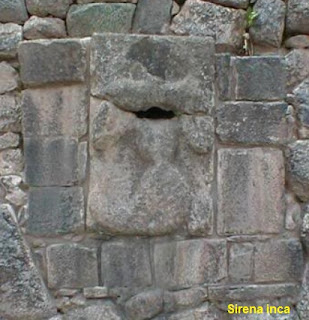Llast November I wrote an entry about Patagonian mermaids, which I translated today into Spanish to post in the "Spanish language" part of this blog. While doing so I decided to do some more research on this interesting being, and I came across the information that I share below:
According to Chilean folklorist Orestes Plath [1], the word used to name the Chiloé mermaid, Pincoya , is not a word of the Mapuche language. It is Quechua (the language of the Andean natives of Peru and Bolivia), and it means "princess or wife of the Inca Emperor".
That means that the mermaid myth is not local but of Inca origin. The word "Coya" means, in Quechua, "wife of the Inca emperor".[2]
That the mermaid is of Inca origin can be seen in the following remark: [3]
All that remains of the palace of the Incas in the present day is a wall eighty-four paces long and eight high, […] on the lower wall the figure of a mermaid, or syren is carved in relief on a square slab[3]
This relief can still be seen at the palace of Manco-Capac, Colcampata (Qollqanpata, Qolqanpata), and is known as the “Sirena” (mermaid). It has “a fish's tail, about a yard [91 cm] high […] it much resembles the mermaid-like figures on one of the Carthagininan mosaics in the British Museum” [4]
The mermaid can be seen in the following image:
Mermaid carved in stone at Cusco, Peru. Taken from [5] ('a carved mermaid')
Landlocked mermaids
In the southern Peruvian province of Lampa (Puno), far from the sea but close to Lake Titicaca there are several places named Sirenayoc. [7] This place name combines the words “sirena” [Spanish] and “yoc" [Quechua] = “who has its" or "who owns", that is, "where there are mermaids".
But these mermaids do not live in the sea nor in Lake Titicaca, they live in “the pure mountain springs” and “rivers where the water flows quickly”. [8]
Mermaids have permeated current popular culture in Peru and they shape has even been incorporated into their local guitars (charango):[9]
Charango (guitar) shaped like a mermaid. From: [9]
Nevertheless, and even though the Andean people had their own water spirits, the question remains unanswered: Why did thy choose to use a Spanish word (sirena) to name their Quechua water beings?. [8] Note that the word pincoya is not found in Peru, it is Chilean.
The fact is that mermaids were taken to Chile by the Inca conquerors who added that country to their empire in 1430 and held it until the Spanish conquest of America. With their armies, came farmers who also brought their beliefs with them. These were adopted by the conquered locals and soon became part of the native lore. This has also happened with several other myths (snakes, double headed condors and so on).
Pincoya became adapted to her new Chilean environment and from being a freshwater creature, became a sea dweller, and adopted the shape of sea creatures:
Her shape varies according to different locations, mostly she is described as having the lower part of her body fish-shaped. But, in Linao, she has feet shaped like the fins of a sea wolf.[10]
She nevertheless kept her taste for freshwater because she is also found on the marshes and bogs (mallin) of Chiloé.[10]
This is a very interesting subject and I will keep on researching (were there any mermaids among the coastal Peruvians? which is the oldest record in Chile regarding mermaids?).
Bibliography.
[1] Plath, Oreste, (1994). Geografía del mito y la leyenda chilenos. Grijalbo. pp. 322
[2] Anales de la Universidad de Chile. (1950). Imprenta del Siglo. pp. 46
[3] Markham, Clements. (1856). Cuzco, the ancient capital of the Incas. The New Monthly Magazine. London. Vol. 106. pp. 443
[4] Bollaert, William. (1865 – 6). Contributions to an introduction to the Anthropology of the New World. Memoirs read before the Anthropological Society of London. Vol. 2, pp. 143
[5] Photograph by MONINCC Qollqanpata. 21.09.2009.
[6] Renato Cárdenas Alvarez. (1997) El Libro de la Mitología de Chiloé. Anaquel Austral. Ed. Virginia Vidal. Santiago : Editorial Poetas Antiimperialistas de América. 15.09.2005.
[7] Gisbert Teresa, (1980). Iconografía y mitos indígenas en el arte. pp. 32
[8] Turino, Thomas. (1983). The Charango and the "Sirena": Music, Magic, and the Power of Love. Latin American Music Review / Revista de Música Latinoamericana Vol. 4, No. 1 (Spring - Summer, 1983), pp. 81-119 1. Spanish version: El Charango y la Sirena: Música, magia y el poder del amor
[9] Photograph from: Charangoperu.com
[10] Contreras O., Constantino. (1966). Estudio lingüístico-folklórico de Chiloé: mitos y actividades laborales rudimentarias.Boletín de filología (1966). Univ. de Chile, Santiago. Vol. 18. pp. 133+
Lea este post en español
Patagonian Monsters - Cryptozoology, Myths & legends in Patagonia2010 International Year of Biodiversity Copyright 2009-2010 by Austin Whittall ©



















No comments:
Post a Comment